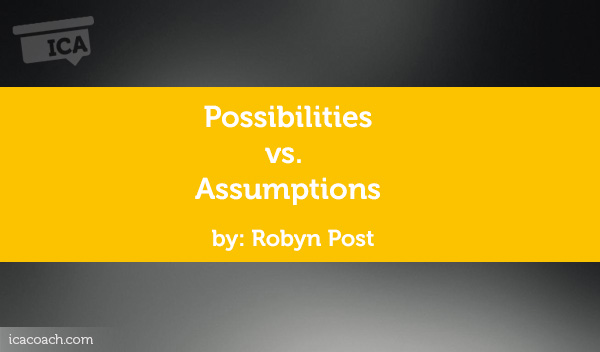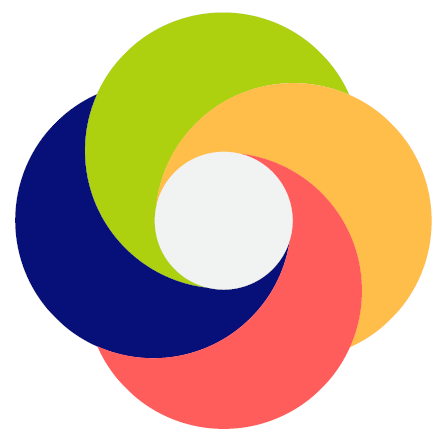
A Coaching Power Tool Created by Robyn Post
(Business Coach, UNITED STATES)
Anything’s possible if you’ve got enough nerve. – JK Rowling

Possibility: The chance that something may exist, happen or be true.
In our earliest years as children, we’re open to most anything. We’re more creative, bold, fearless. We don’t think about who likes us; we assume everyone does. If we’re asked to draw a house, it doesn’t have to look like a house. It can look like a car or a butterfly. And it doesn’t have to be a muted shade of beige or white or grey. It can be filled in unabashedly with wild colors, shapes, and textures. Practicality or logic doesn’t come into play. Our creativity is unleashed and unbound.
Children seem to live in a field where all possibilities exist.
As we get older and we see how we’re supposed to draw a house, and what colors and shapes are customary and acceptable to others, we draw differently. We tamp down our sense of play and whimsy. We learn that a car should look this way and a bird should look that way. Our field of possibilities narrows. We work within the lines. We grow self-conscious. We start to limit ourselves to the ideals that already exist, assuming they are more accurate than our own. Our creativity and full potential get blocked.
We grow up in a world of should and don’t and never and start to judge ourselves and everything else against what is outside of us. We begin to feel uncomfortable expressing what comes naturally and comes from within, especially if it doesn’t match outside expectations.
A study done in the 1960s best illustrates this. Researchers tested the IQ of 1600 children between the ages of three and five years old. Out of the 1600, 98% of them tested as geniuses. Five years later, at ages eight to 13, the same children were tested again and only about 32% were still in the genius zone. By ages 13 to 18, only 10% of the students tested as genius. Their intellect and creativity had significantly declined.
Recently I heard a statement that sounded viable: As children we hear the word “no” much more frequently than we hear the word “yes.” We begin early on to understand what we can’t do, shouldn’t do, what’s not possible, or what’s going to be too difficult for us to accomplish. In other words, a world of assumptions.
What we pick up from outside of us can thwart the genius inside of us.
This is what assumptions can do. Assumptions are narratives we believe to be true about ourselves, our environment and what’s possible. Often they are faulty, yet we keep relying on them as if they are true. That is, until we gain awareness. For example, a popular assumption is:
Someone with this assumption will likely put in less effort and achieve less than someone who does not have this assumption and pursues the work or pay even if they do not have credentials.
The one who is open to the chance that something may exist, happen or be true, even when to others it seems unlikely, has a chance of success the other does not.
Coaching application
Coaching is so often about challenging assumptions, both our clients’ and our own. And as coaches we already may ask our clients, in some form, the powerful question: What’s possible here?
Here are additional questions to ask yourself or your client to determine “assumptions thinking.”
But the most powerful question may be:
In order to tap into and discover what you’re capable of, it’s important to challenge any assumptions that have kept you from living your desired life or achieving your desired goals. And seek to look through the lens of pure potentiality that once existed within you—that place where you continually seek out and engage possibility.
How to engage possibility
To bring a client into “possibilities thinking,” there are simple questions or exercises that help them see beyond their limiting beliefs to a new vista they may have not yet have thought to (or allowed themselves to) explore.
There are two exercises I like to use to help clients shift into a new way of thinking. One that helps them feel more empowered toward creating and achieving what they most want. I encourage them to apply these exercises outside of coaching sessions, whenever they feel stuck and want to get into action.

Have the client state the goal or what he or she wants to achieve or create.

Then choose one of the following exercises or use them in succession:

HOW CAN I?
Reminding the client that within them is a powerful storehouse of wisdom, and encouraging them to set aside limits and tap into a sense of possibility, invite the client to finish this sentence with respect to the goal.
HOW CAN I ___________________[achieve this goal, create this scenario]?
Example: How can I have a great day today despite challenges I’m having? Or How can I bring in 2 new clients today?
These 3 powerful words “How Can I” can activate the brain’s executive functions which can help you generate ideas, map out plans, notice opportunities, feel more motivated.
You’re guiding the client to visualize something they believe isn’t possible for them. This can help them open up their thinking and tap into their creativity.
You can then:

I CHOOSE.
Studies show our words impact our emotions and ultimately how we “show up” and our choices and outcomes. Certain words can make us feel more empowered and in control. For example, the phrase “I hope to…” or “I can….” makes us feel different than when we use the phrase “I choose….”
The phrase “I choose” is especially powerful because it implies three things: (1) That you are taking charge and being an active agent in your life; (2) that you are making a decision that comes from within, and (3) that you are making a commitment.
I CHOOSE_____________________ [the desired outcome].
Example: I choose to carry myself as a confident leader in work today. Or I choose to buy a neon green car regardless of others may think.
Invite the client to choose something that makes them feel connected to their inner selves and excited and engaged in their decision.
Then you can:
A simple shift in language can help clients tap into what comes from within, rather than outside of themselves (and ignore the “shoulds”). It also helps them feel more in control, while activating their creativity. We open up our possibilities when we allow ourselves to let go of assumptions, show up in our own way, become active agents in our lives, and most of all, when we tap back into our sense of play.